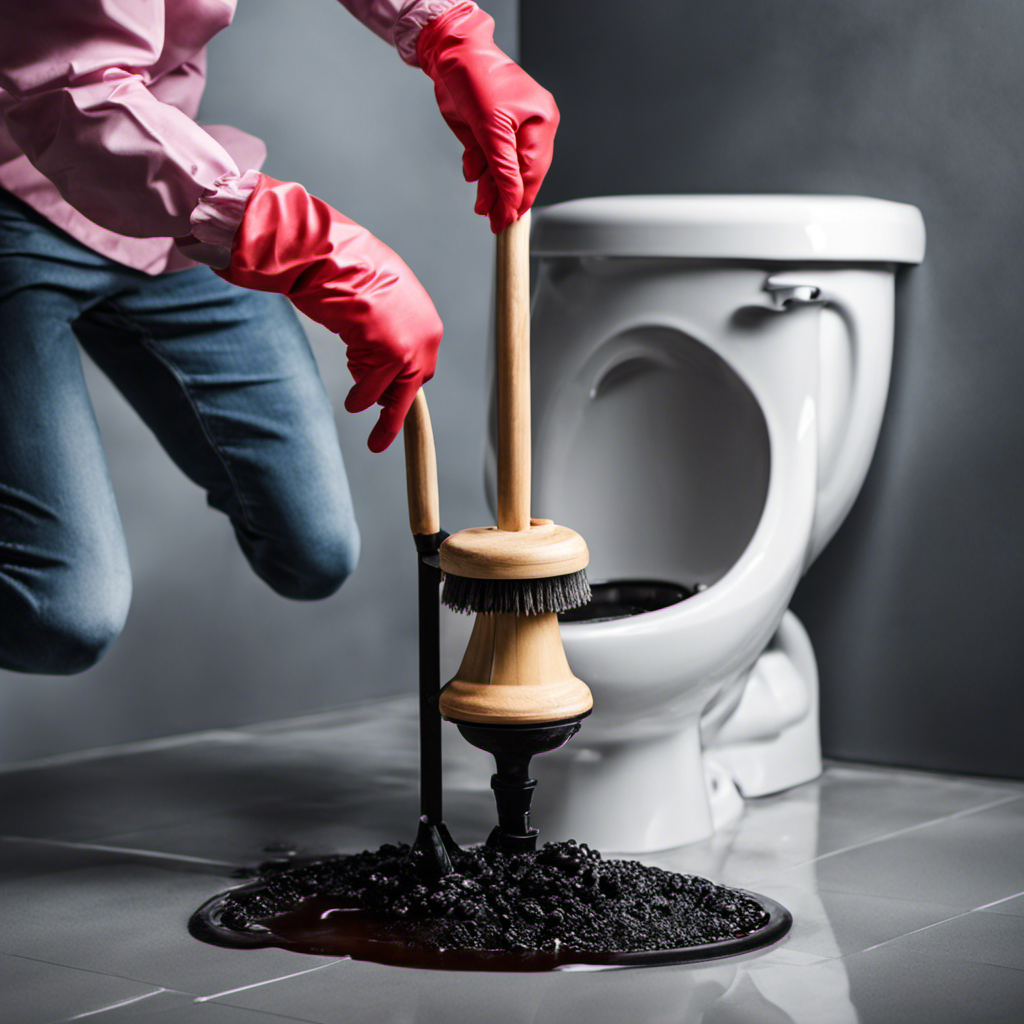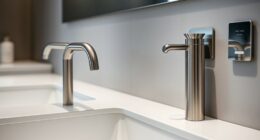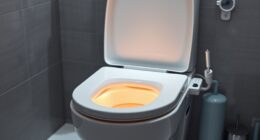Did you know that clogged toilets are one of the most common plumbing issues homeowners face?
Well, fear no more! In this article, I’ll share a step-by-step method to unclog your toilet quickly and efficiently. With just a few tools and supplies, you’ll be able to tackle even the most stubborn clogs.
Plus, I’ll provide some helpful tips for preventing future clogs.
So, let’s dive in and get your toilet back to working order in no time!
Key Takeaways
- Flushing excessive amounts of toilet paper at once can easily lead to a clog in your plumbing system.
- Addressing a clog as soon as possible can prevent further complications.
- A plunger with a flange that fits snugly into the drain hole is essential for unclogging a toilet.
- A mixture of baking soda and vinegar can help break up stubborn clogs.
Common Causes of Toilet Clogs
One of the most common causes of toilet clogs is when you flush excessive amounts of toilet paper at once. While it may seem convenient to flush down a large wad of toilet paper, it can easily lead to a clog in your plumbing system.
To prevent toilet clogs, it is important to be mindful of how much toilet paper you are flushing down. A good rule of thumb is to flush small amounts at a time and give the toilet time to clear before flushing again.
Additionally, be on the lookout for signs of a clogged toilet, such as water backing up or draining slowly. If you notice these signs, it is best to address the clog as soon as possible to avoid further complications.
Tools and Supplies Needed
To get started, all you’ll need are a plunger and a pair of rubber gloves.
Unclogging a toilet may seem like a daunting task, but with the right tools and techniques, you can easily tackle the problem yourself.
The plunger is the most common tool used for unclogging toilets. Make sure you have a sturdy one with a flange that fits snugly into the drain hole.
Put on your rubber gloves to protect your hands from any unpleasant mess. Position the plunger over the drain hole and gently push down, then pull up quickly to create suction. Repeat this motion several times until the water starts to drain.
If the plunger doesn’t work, you can try using a toilet auger or a homemade solution of hot water and dish soap.
These DIY toilet repair methods are simple and effective, saving you time and money.
Step-by-Step Toilet Unclogging Method
Start by ensuring you have a plunger and a pair of rubber gloves ready to tackle the clogged toilet.
Toilet unclogging techniques can be simple if you follow a step-by-step method. First, put on the rubber gloves to protect your hands from any mess.
Next, position the plunger over the drain hole and apply firm downward pressure, followed by a quick upward motion. Repeat this plunging action several times until the water starts to drain.
If the plunger doesn’t work, try using a toilet auger, also known as a snake, to break up the clog. Insert the auger into the drain hole and turn the handle clockwise to push through the obstruction.
DIY toilet repairs can save you time and money, so don’t hesitate to try these techniques before calling a plumber.
Tips and Tricks for Stubborn Clogs
If you’re dealing with a stubborn clog, try using a mixture of baking soda and vinegar to help break it up. This is one of the most effective home remedies for unclogging toilets.
Simply pour half a cup of baking soda into the toilet bowl, followed by half a cup of vinegar. Let the mixture sit for about 30 minutes, allowing it to fizz and break down the clog.
After that, flush the toilet and see if the clog has cleared. If the clog remains, it may be time to call in professional plumbing services. They have the tools and expertise to tackle even the most stubborn clogs and ensure your toilet is flowing smoothly again.
Preventing Future Toilet Clogs
One way you can prevent future clogs is by being mindful of what you flush down the toilet. Regular toilet maintenance and proper flushing techniques are crucial for keeping your toilet clog-free.
It’s important to remember that toilets are designed to handle human waste and toilet paper. Flushing anything else, such as wipes, feminine hygiene products, or excessive amounts of toilet paper, can lead to clogs. To prevent this, make sure to dispose of these items in the trash instead.
Additionally, regular maintenance, such as using a plunger or a toilet auger when necessary, can help prevent small clogs from turning into major plumbing issues. By being mindful of what you flush and practicing proper maintenance, you can save yourself the hassle and expense of dealing with a clogged toilet.
Conclusion
In conclusion, unclogging a toilet can be a frustrating and messy task. However, with the right tools and a step-by-step approach, it can be easily accomplished.
By understanding the common causes of toilet clogs and following the proper method, you can successfully clear the blockage and restore your toilet’s functionality.
Remember to use caution and take preventative measures to avoid future clogs. With a little knowledge and practice, you’ll be equipped to handle any toilet clog that comes your way.










